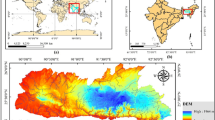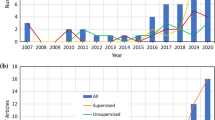Abstract
Many geology, mining, and geotechnical applications require or depend upon some form of modeling of bedrock topography. Optimizing the manner with which bedrock topography is modeled poses a significant challenge because of the unpredictable or erratic presentation of the surface shape of bedrock. Unlike surface topography, bedrock topography is more difficult to determine because direct observation points are often not readily or directly accessible, unless the bedrock outcrops at the surface and is exposed, a relatively rare occurrence. When bedrock is covered by granular deposits, the only methods that allow practitioners to objectively establish the location of the top of the bedrock are to drill boreholes or conduct geophysical surveys. This makes the determination of bedrock topography not only difficult but also expensive. This study proposes a new approach for optimizing the modeling of complex bedrock topography, whose originality is based on the addition of “virtual” data points derived from cross-sections located between known boreholes. The proposed methodology is thus composed of four steps: gathering the maximum amount of relevant surface and subsurface data (from observation points), selecting the most appropriate technique for interpolating the observed bedrock elevations that will be entered into the dataset to be modeled, enriching the quantity of modeling data by adding “virtual” data elements based on geological interpretations of cross-sections (inserted into the model alongside the original objective data), and finally the modeling itself. The proposed approach is illustrated using data from a study area located in the Canadian Shield. Thousands of borehole records and surficial geological data as well as geological cross-section records were integrated to construct a three-dimensional bedrock topography model. The new proposed methodology can be applied to other regions worldwide.



















Similar content being viewed by others
References
Carmichael RS, Henry G (1977) Gravity exploration for groundwater and bedrock topography in glaciated areas. Geophysics 42(4):850–859
Carrara A, Bitelli G, Carla R (1997) Comparison of techniques for generating digital terrain models from contour lines. Int J Geogr Inf Sci 11(5):451–473
Carter J (1992) The effect of data precision on the calculation of slope and aspect using grid DEMs. Cartographica 29(1):22–34
Chang K-T, Tsai B-W (1991) The effect of DEM resolution on slope and aspect mapping. Cartography and Geographic Information Systems 18(1):69–77
Chaplot V, Darboux F, Bourennane H, Leguedois S, Silvera N, Phachomphon K (2006) Accuracy of interpolation techniques for the derivation of digital elevation models in relation to landform types and data density. Geomorphology 77:126–141
Chesnaux R (2013) Regional recharge assessment in the crystalline bedrock aquifer of the Kenogami uplands, Canada. Hydrol Sci J 58(2):421–436
Chesnaux R, Lambert M, Fillastre U, Walter J, Hay M, Rouleau A, Daigneault R, Germaneau D, Moisan A (2011) Building a geodatabase for mapping hydrogeological features and 3D modeling of groundwater systems: application to the Saguenay-Lac-St-Jean region, Canada. Comput Geosci 37:1870–1882
Darsow A, Schafmeister M-T, Hofmann T (2009) An ArcGIS approach to include tectonic structures in point data regionalization. Groundwater 47:591–597
Elmahdy SI, Mansor S, Rodsi A, Bujang BK (2010) Geotechnical modeling of fractures and cavities that are associated with geotechnical engineering problems in Kuala Lumpur limestone, Malaysia. Environmental Earth Sciences 62(1):61–68
Farinotti D, King EC, Albrecht A, Huss M, Gudmundsson Hilmar G (2014) The bedrock topography of Starbuck Glacier, Antarctic Peninsula, as determined by radio-echo soundings and flow modeling. Ann Glaciol 55(65):22–28
Jones NL, Davis RJ, Sabbah W (2003) A comparison of three-dimensional interpolation techniques for plume characterization. Groundwater 41:411–419
MacCormack KE, Brodeur JJ, Eyles CH (2011) Assessing the impact of data quantity, distribution and algorithm selection on the accuracy of 3D subsurface models, Proceeding of the GeoHydro 2011 conference, Quebec City, Quebec, Canada, 6pp
Paulen RC, McClenaghan MB (2003) Three-dimensional bedrock topography and drift thickness models from the Timmins Area, northeastern Ontario: An application of GIS to the Timmins Overburden Drillhole Database, On the Edge: Earth Science at North America’s Western Margin. Annual Meeting of the GAC, MAC and SEG. Sheraton Wall Centre, Vancouver, British Columbia. May 25–28, 2003
Slattery SR, Barker AA, Andriashek LD, Jean G, Stewart SA, Moktan H, Lemay TG (2011) Bedrock topography and sediment thickness mapping in the Edmonton-Calgary Corridor, Central Alberta: an overview of protocols and methodologies, ercb/ags open file report 2010–12
Tremblay Simard P, Chesnaux R, Rouleau A, Daigneault R, Cousineau PA, Roy DW, Lambert M, Poirier B, Poignant-Molina L (2015) Imaging glacial quaternary deposits and basement topography using the transient electromagnetic method for modeling aquifer environments. J Appl Geophys 119:36–50
Ugwu SA, Eze CL (2009) Mapping bedrock topography using electromagnetic profiling. J Appl Sci Environ Manag 13(4):43–46
Van Hoesen JG (2014) A geographic information systems (GIS)-based approach to derivative map production and visualizing bedrock topography within the town of Rutland, Vermont, USA. International Journal of Geo-Information 3:130–142
Wise S (2000) Assessing the quality for hydrological applications of digital elevation models derived from contours. Hydrol Process 14:1909–1929
Zimmerman D, Pavlik C, Ruggles A, Armstrong MP (1999) An experimental comparison of ordinary and universal kriging and inverse distance weighting. Math Geol 31:375–390
Acknowledgments
The authors wish to acknowledge the financial support of the “Ministère du Développement Durable et de la Lute contre les Changements Climatiques (MDDELCC)” of the province of Quebec (Canada), as well as the “Conseil regional des élus” (regional Council of elected representatives) and the different regional municipality groups of the Saguenay-Lac-St-Jean region. The manuscript benefited from fruitful review by two anonymous reviewers and the editor Dr. Rafael Moreno. Proofreading of the manuscript has been kindly performed by Josée Kaufmann.
Author information
Authors and Affiliations
Corresponding author
Rights and permissions
About this article
Cite this article
Chesnaux, R., Lambert, M., Walter, J. et al. A simplified geographical information systems (GIS)-based methodology for modeling the topography of bedrock: illustration using the Canadian Shield. Appl Geomat 9, 61–78 (2017). https://doi.org/10.1007/s12518-017-0183-1
Received:
Accepted:
Published:
Issue Date:
DOI: https://doi.org/10.1007/s12518-017-0183-1




